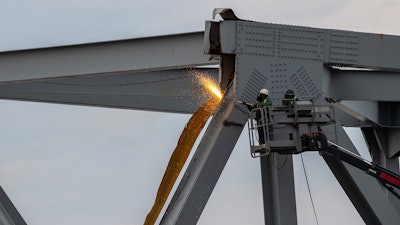
Work is underway on removing the remains of the I-695/Francis Scott Key Bridge in Baltimore, and a temporary alternate shipping channel has been established for commercially essential vessels.
Crews began cutting the metal trusses with blow torches March 30 on the collapsed sections of the bridge. The bridge was hit March 26 by a large cargo ship after it lost power and slammed into one of the pillars. The central spans of the metal truss bridge immediately collapsed, closing boat traffic to the Port of Baltimore and vehicle traffic on I-695 near the port. The port is No. 1 in the U.S. for roll-off, roll-on cargo of heavy construction and farming equipment, as well as cars and light trucks.
For video of the salvage operation, see the end of this story.
Six of eight workers on the bridge patching potholes at the time of the crash are presumed dead. Two were rescued, one with serious injuries. Two workers’ bodies were located underwater. The search for the remains of the other four workers will resume after salvage operations enable safe search efforts, officials say.
Salvage and rescue operations are being led by the Bridge Response Unified Command. Demolition crews have been cutting portions of the north side of the collapsed bridge truss since March 30. Two cranes – weighing 650 tons and 330 tons – have been barged in and are being used to load the wreckage onto a barge for removal. Another land-based 250-ton crane is offloading the wreckage at the nearby Tradepoint Atlantic global logistics center. Tradepoint is also coordinating additional shipping traffic to the site while the port remains closed.
“Every lifting operation requires engineering analysis to inform salvage operation plans,” according to the Unified Command.
 Demolition crews begin cutting the top portion of the north side of the collapsed bridge into smaller sections for removal by crane March 30. Salvage teams are using exothermic cutting torches to systematically separate sections of the steel bridge, which will be taken to a disposal site.U.S. Coast Guard photo by Petty Officer 3rd Class Kimberly Reaves
Demolition crews begin cutting the top portion of the north side of the collapsed bridge into smaller sections for removal by crane March 30. Salvage teams are using exothermic cutting torches to systematically separate sections of the steel bridge, which will be taken to a disposal site.U.S. Coast Guard photo by Petty Officer 3rd Class Kimberly Reaves
- Stabilize the cargo ship Dali, which remains trapped under the bridge wreckage, to prevent pivoting. Three dive teams are surveying bridge sections and Dali for removal.
- Analyze internal bridge truss structure.
- Cut diagonal truss to lift from vessel and swing wreckage for removal.
- Refloat the Dali away from the wreckage.
- Disassemble and remove bridge.
The Unified Command has worked with BGE to reduce pressure in a natural gas pipeline that is underneath the wreck site and spans the width of the ship channel, and eventually cut off supply to the pipe.
As to the temporary alternate channel, it is marked with government lighted aids to navigation. It has a controlling depth of 11 feet, a 264-foot horizontal clearance, and vertical clearance 96 feet, according to Unified Command.
“This will mark an important first step along the road to reopening the port of Baltimore,” said Capt. David O’Connell, federal on-scene coordinator, Key Bridge Response 2024. “By opening this alternate route, we will support the flow of marine traffic into Baltimore.”
A 2,000-yard safety zone has been established around the bridge to protect personnel, vessels and the marine environment.
So far, no timeline on when the wreckage will be removed and the port will reopen has been established. President Joe Biden has appropriated $60 million in emergency federal aid for cleanup operations and to reopen the port.
The National Transportation Safety Board is investigating the crash and the bridge collapse.
The Key Bridge Response 2024 Unified Command includes the following:
- U.S. Coast Guard
- U.S. Army Corps of Engineers
- Maryland Department of the Environment
- Maryland Transportation Authority
- Maryland State Police
- Witt O’Brien’s representing Synergy Marine.
The Key Bridge Response Unified Command released video of the bridge collapse response:











